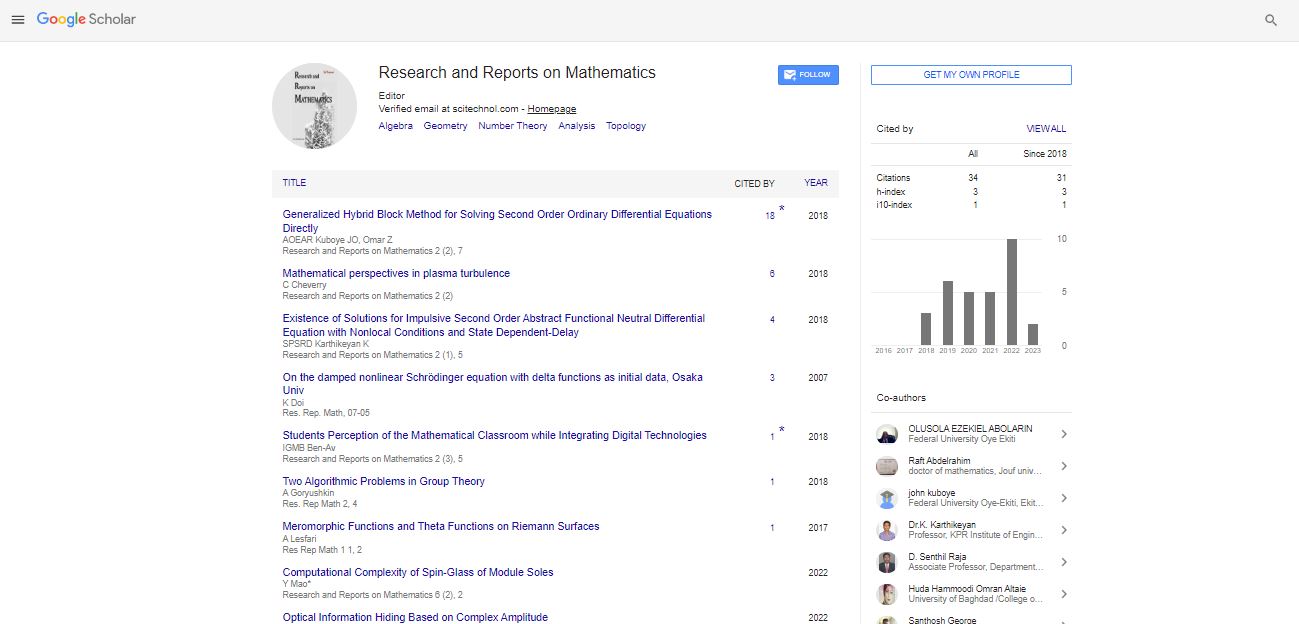Commentary, Res Rep Math Vol: 7 Issue: 4
The Elegance of Numbers and the Vision of Shapes in Mathematics
Raimundo Andrea*
1Department of Mathematics, Physics and Statistics, Catholic University of Maule, Maule, Chile
*Corresponding Author: Raimundo Andrea,
Department of Mathematics,
Physics and Statistics, Catholic University of Maule, Maule, Chile
E-mail: raimundo.andrea@cu.edu.cl
Received date: 28 July, 2023, Manuscript No. RRM-23-113484;
Editor assigned date: 30 July, 2023, Pre QC No. RRM-23-113484 (PQ);
Reviewed date: 14 August, 2023, QC No. RRM-23-113484;
Revised date: 23 August, 2023, Manuscript No. RRM-23-113484 (R);
Published date: 31 August, 2023, DOI: 07.4172/rrm.10001208
Citation: Andrea R (2023) The Elegance of Numbers and the is Vision of Shapes in Mathematics. Res Rep Math 7:4.
Description
Number theory and algebraic geometry are two profound branches of mathematics that, at first glance, might appear distinct. Number theory delves into the properties and relationships of integers, while algebraic geometry discuss geometric shapes defined by polynomial equations. However, deeper into these fields, it becomes evident that they share intricate connections, illuminating the profound interplay between numbers and shapes in mathematics will be discussed. In this exploration, we embark on a journey to understand the intriguing intersection of number theory and algebraic geometry and appreciate how these disciplines enrich each other. Number theory is the study of the properties and relationships of integers, whole numbers without fractions or decimals. It's one of the oldest and most fundamental branches of mathematics, with a history dating back to ancient times. Key concepts in number theory include prime numbers, divisibility, congruence’s, and Diophantine equations.
Prime numbers are the central characters in number theory. They are natural numbers greater than 1 that have no divisors other than 1 and themselves. Primes play a fundamental role in number theory, as they form the building blocks of all other integers. Mathematicians have been captivated by the distribution of primes, their properties, and the existence of patterns within them. Diophantine equations are polynomial equations that seek integer solutions. They are named after the ancient Greek mathematician Diophantus, who was among the first to study them. These equations often involve questions about the number of solutions, the existence of solutions, and the nature of solutions in integers.
Famous examples include Fermat's Last Theorem, which remained unsolved for centuries until Andrew Wiles provided a proof in the 1990s. Congruence’s are a central concept in number theory. They involve the study of numbers where nn is a positive integer. Modular arithmetic is not only a mathematical playground in its own right but also a tool used extensively in cryptography and computer science. It provides a framework for understanding cyclic behavior and patterns in number sequences. Algebraic geometry, on the other hand, is a branch of mathematics that dscusss geometric shapes defined by polynomial equations. In this field, geometric objects like curves and surfaces are represented by algebraic equations, blurring the boundary between geometry and algebra. Key concepts include algebraic varieties, affine and projective spaces, and morphisms.
Algebraic varieties are geometric objects defined by polynomial equations. These objects can be as simple as lines and circles or as complex as high-dimensional surfaces. The study of algebraic varieties involves understanding their properties, intersections, and relationships, all of which are encoded in the algebraic equations that define them. Algebraic geometry distinguishes between affine and projective spaces. Affine space corresponds to Euclidean space, where every point is specified by coordinates. In contrast, projective space includes "points at infinity," making it a more comprehensive setting for studying algebraic varieties. This distinction leads to deeper insights into geometric properties and relationships. Morphisms are structure-preserving maps between algebraic varieties. They allow mathematicians to analyze how one variety can be transformed or mapped onto another while preserving its essential geometric properties. Morphisms play a dire role in understanding the relationships between different geometric objects.
The intersection of number theory and algebraic geometry reveals captivating connections between these seemingly distinct fields. Here are some remarkable intersections, Elliptic curves are a prime example of how number theory and algebraic geometry intertwine. These curves are defined by cubic equations and have deep connections to number theory. They are central in modern cryptography, particularly in schemes like Elliptic Curve Cryptography (ECC), which relies on the difficulty of certain number-theoretic problems for security. Modular forms are complex functions with deep ties to both number theory and algebraic geometry. They are used to study certain types of Diophantine equations and are closely connected to elliptic curves. These functions have been instrumental in proving long-standing conjectures like Fermat's Last Theorem.
Arakelov theory is a branch of mathematics that explicitly connects number theory and algebraic geometry. It extends the concepts of both fields by incorporating complex analysis and measures, allowing for a richer understanding of arithmetic and geometric properties. The Birch and Swinnerton-Dyer conjecture is a profound problem in number theory that connects to the geometry of elliptic curves. It posits that the number of rational points on an elliptic curve is related to certain properties of the curve's associated L-function. Solving this conjecture would provide deep insights into the interplay of numbers and shapes. Number theory and algebraic geometry, despite their seemingly disparate natures, share an intimate and harmonious interplay. Their intersection has led to profound discoveries, not only shedding light on long-standing mathematical problems but also finding practical applications in cryptography, coding theory, and beyond. This rich symbiosis illustrates the depth and beauty of mathematics and serves as a testament to the unifying power of mathematical abstraction in our quest to understand the world of numbers and shapes.
 Spanish
Spanish  Chinese
Chinese  Russian
Russian  German
German  French
French  Japanese
Japanese  Portuguese
Portuguese  Hindi
Hindi 